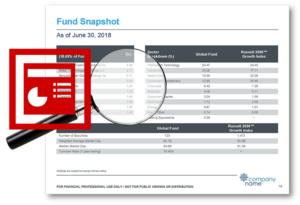Search Results for: feed
The Growing Importance of ADA Compliance for Investment Companies

The asset management industry stands at a pivotal crossroads where inclusivity and accessibility are not just niceties but necessities.
The growing importance of ADA (Americans with Disabilities Act) compliant investment marketing materials is a testament to the industry’s commitment to serving a diverse clientele, and also to the evolving regulatory environment in which they operate.
Around 20 million Americans (8% of the population) live with some level of visual impairment. ADA compatibility helps ensure that individuals with disabilities have equal access to financial resources and services, which is crucial in fostering an inclusive economy.
New Privacy Policy
SYNTHESIS TECHNOLOGY LLC, PRIVACY NOTICE
Policy version: June 2024
Synthesis Technology, LLC and its affiliates (“Synthesis Technology”, “we”, “our” or “us”) take your privacy seriously, we are committed to protecting and respecting your privacy. This Privacy Notice (the “Notice”) describes how we will collect and use your information (which includes your personal data), both from your use of this website and through any services that we may provide to you and the rights you have in relation to your information. If you have questions, comments, or concerns about this Notice or our processing of personal data, please see the bottom of this Notice for information about how to contact us.
By using any of our services, including this website, and by providing us with any personal data, you acknowledge the use of your personal data as set out in this Notice, including that you are sharing your data with an organization that is based in the United States of America and who has processing operations in India. Please do not browse our website any further, or send us personal data, if you do not want that information to be used in this way.
Synthesis Technology is the controller of personal data obtained via our website and during our relationship with you, meaning we are the organisation legally responsible for deciding how and for what purposes it is used.
When we do so we are subject to the UK General Data Protection Regulation (“UK GDPR”) and the EU General Data Protection Regulation (“EU GDPR”) (together, the “GDPR”) in relation to goods and services we offer to individuals in the European Economic Area (EEA).
OVERVIEW
WHAT THIS POLICY APPLIES TO
PERSONAL DATA WE COLLECT ABOUT YOU
- Categories of Personal Data We Collect
- How Your Personal Data Is Collected
- How And Why, We Use Your Personal Data
- Marketing
- Who We Share Your Personal Data With
TRANSFERRING YOUR PERSONAL DATA OUT OF THE UK AND EEA
COOKIES
YOUR RIGHTS
- Individuals based in the UK or EEA
OTHER IMPORTANT INFORMATION ABOUT PERSONAL DATA AND THE SERVICES
- How Long Your Personal Data Will Be Kept
- Keeping Your Personal Data Secure
- Collection of Personal Data From Children
ADDITIONAL INFORMATION AND ASSISTANCE
- How To Complain
- UK/EEA Complaints
- Changes To This Privacy Policy
- How To Contact Us
1) WHAT THIS POLICY APPLIES TO
This privacy policy relates to your use of our website and services.
Throughout our website we may link to other websites owned and operated by certain trusted third parties, for example, to our LinkedIn profile. Those third-party websites may also gather information about you in accordance with their own separate privacy notices. For privacy information relating to those third-party websites, please consult their privacy notices as appropriate.
2) PERSONAL DATA WE COLLECT ABOUT YOU
a) Categories of Personal Data We Collect
The personal data we collect about you depends on the activities carried out through our website and the services we provide to you. As applicable to your interaction with Synthesis website or product we may collect and use.:
- your name, address, company name, position and contact information, including address, email address and telephone number;
- your account details, such as username and login details;
- location data, if you choose to give this to us;
- details of any information, feedback or other matters you give to us by phone, email, post or via social media;
- your activities on, and use of, our website;
- information about the services we provide to you; and
- information about how you use our website and technology systems.
You must provide this personal data to use our services, unless we tell you that you have a choice. Synthesis does NOT engage in any data mining or purchasing of personal information. The information we may hold has been provided by permission by our users or their employers as part of their commercial relationship with Synthesis.
Sometimes you can choose if you want to give us your personal data and let us use it. Where that is the case we will tell you and give you the choice before you give the personal data to us. We will also tell you whether declining to share that personal data will have any effect on your use of our website or any services we provide.
We collect and use this personal data for the purposes described in the section ‘How and why we use your personal data’ below.
For the avoidance of doubt, we do not collect special category personal data, and you should not share this type of personal data with us.
b) How Your Personal Data Is Collected
We collect personal data from you:
- directly, when you sign up for our services, register to use our platform, or send us information, such as when you contact us via our website, via email, send us feedback, sign up for our newsletter or provide us your details at an industry event; and
- indirectly, such as from our clients in the provision of our services to them, and when you browse on our website (see ‘Cookies’ below).
c) How And Why, We Use Your Personal Data
Under data protection law, we can only use your personal data if we have a proper reason, e.g.:
- for the performance of a contract with you or to take steps at your request before entering into a contract;
- to comply with our legal and regulatory obligations;
- for our legitimate interests or those of a third-party; or
- where you have given consent;
A legitimate interest is when we have a business or commercial reason to use your personal data, so long as this is not overridden by your own rights and interests. We will carry out an assessment when relying on legitimate interests, to balance our interests against your own.
The section below explains what we use your personal data for and why.
Providing services to you/our client.
- Our reasons: To perform our contract with our client or to take steps at our client’s request before entering into a contract. Our services may involve our client’s processing their customer data on our platform.
Conducting checks to identify you and verify your identity or to help prevent and detect fraud against you or us.
- Our reasons: To comply with our legal and regulatory obligations, or for our legitimate interests, i.e. to minimise fraud that could be damaging for you and/or us.
Enforcing legal rights or defend or undertake legal proceedings.
- Our reasons: Depending on the circumstances:
- to comply with our legal and regulatory obligations; and/or
- in other cases, for our legitimate interests, i.e. to protect our business, interests and rights.
Customising our website and its content to your preferences, based on a record of your selected preferences or on your use of our website.
- Our reasons: Depending on the circumstances:
- your consent as gathered e.g. via our cookies (see ‘Cookies’ below);
- where we are not required to obtain your consent and do not do so, for our legitimate interests, i.e. to be as efficient as we can so we can deliver the best service to you.
Retaining and evaluating information on your recent visits to our website and how you move around different sections of our website for analytics purposes to understand how people use our website so that we can make it more intuitive or to check our website is working as intended.
- Our reasons: Depending on the circumstances:
- your consent as gathered e.g. via our cookies (see ‘Cookies’ below);
- where we are not required to obtain your consent and do not do so, for our legitimate interests, i.e. to be as efficient as we can so we can deliver the best service to you.
Communications with you not related to marketing, including about changes to our terms or policies or changes to the services or other important notices.
- Our reasons: Depending on the circumstances:
- to comply with our legal and regulatory obligations;
- in other cases, for our legitimate interests, i.e. to be as efficient as we can so we can deliver the best service to you.
Protecting the security of systems and data used to provide the services.
- Our reasons: – To comply with our legal and regulatory obligations.
- We may also use your personal data to ensure the security of systems and data to a standard that goes beyond our legal obligations, and in those cases our reasons are for our legitimate interests, i.e. to protect systems and data and to prevent and detect criminal activity that could be damaging for you and/or us.
Statistical analysis to help us understand our customer base.
- Our reasons: For our legitimate interests, i.e. to be as efficient as we can so we can deliver the best service to you.
Updating and enhancing customer records.
- Our reasons: Depending on the circumstances:
- to perform our contract with you or to take steps at your request before entering into a contract;
- to comply with our legal and regulatory obligations
- where neither of the above apply, for our legitimate interests, e.g. making sure that we can keep in touch with our customers about existing orders and new products.
Disclosures and other activities necessary to comply with legal and regulatory obligations that apply to our business, e.g., to record and demonstrate evidence of your consents where relevant.
- Our reasons: To comply with our legal and regulatory obligations.
Marketing our services to existing and former customers.
- Our reasons: For our legitimate interests, i.e. to promote our business to existing and former customers.
To share your personal data with members of our group to provide our services.
- Our reasons: To perform our contract with our client or to take steps at our client’s request before entering into a contract.
To share your personal data with third parties that will or may take control or ownership of some or all of our business (and professional advisors acting on our or their behalf) in connection with a significant corporate transaction or restructuring, including a merger, acquisition, asset sale, initial public offering or in the event of our insolvency.
In such cases information will be anonymised where possible and only shared where necessary.
- Our reasons: Depending on the circumstances:
- to comply with our legal and regulatory obligations; and/or
- in other cases, for our legitimate interests, i.e. to protect, realise or grow the value in our business and assets.
d) Marketing
We will use your personal data to send you updates by email about our services, including exclusive offers, promotions or new services.
We have a legitimate interest in using your personal data for marketing purposes (see above ‘How and why we use your personal data’). This means we may not need your consent to send you marketing information. Where consent is needed, we will ask for this separately and clearly.
You have the right to opt out of receiving marketing communications at any time by (i) contacting us at [email protected], or (ii) using the ‘unsubscribe’ link in emails. We may ask you to confirm or update your marketing preferences if you ask us to provide further services in the future, or if there are changes in the law, regulation, or the structure of our business.
We will always treat your personal data with the utmost respect and never sell or share it with other organisations outside the Synthesis Technology group for marketing purposes.
For more information on your right to object at any time to your personal data being used for marketing purposes, see ‘Your rights’ below.
e) Who We Share Your Personal Data With
Synthesis does not share or sell personal data to any party outside of our Company or close affiliates. If required, we may occasionally share personal data with:
- our external auditors, e.g. in relation to the audit of our accounts, in which case the recipient of the information will be bound by confidentiality obligations;
- our and their professional advisors (such as lawyers and other advisors), in which case the recipient of the information will be bound by confidentiality obligations;
- law enforcement agencies, courts, tribunals and regulatory bodies to comply with our legal and regulatory obligations; and/or
- other parties that have or may acquire control or ownership of our business (and our or their professional advisers) in connection with a significant corporate transaction or restructuring, including a merger, acquisition, asset sale, initial public offering or in the event of our insolvency—usually, information will be anonymised but this may not always be possible. The recipient of any of your personal data will be bound by confidentiality obligations.
If you would like more information about who we share our data with and why, please contact us (see ‘How to contact us’ below).
3) TRANSFERRING YOUR PERSONAL DATA OUT OF THE UK AND EEA
Synthesis Technology is head quartered in the United States of America and has affiliates based in the EU and India, who may process your personal data to provide our services. You acknowledge that by sharing your personal data with us you are transferring this information outside of the UK and EEA, directly to us in the United States of America, and this may be transferred to our affiliate in India. These jurisdictions may have different data protection rules than in your country, and personal data may become accessible as permitted by law in these countries, including to law enforcement and/or national security authorities.
If you are based in the UK or EEA, we will only transfer your personal data in accordance with data protection laws and we only transfer your personal data to a country outside the UK/EEA where:
- in the case of transfers subject to UK data protection law, the UK government has decided the particular country ensures an adequate level of protection of personal data (known as an ‘adequacy decision’). A list of countries the UK currently has adequacy regulations in relation to is available here;
- in the case of transfers subject to EEA data protection laws, the European Commission has decided that the particular country ensures an adequate level of protection of personal data (known as an ‘adequacy decision’). A list of countries the European Commission has currently made adequacy decisions in relation to is available here;
- there are appropriate safeguards in place, together with enforceable rights and effective legal remedies for you. This will most likely be that we have put in place the appropriate standard contractual clauses and carried out a transfer impact assessment; or
- a specific exception applies under relevant data protection law.
Any changes to the destinations to which we send personal data or in the transfer mechanisms we rely on to transfer personal data internationally will be notified to you in accordance with the section on ‘Changes to this privacy policy’ below.
If you would like further information about data transferred outside the UK and EEA, please contact us (see ‘How to contact us’ below).
4) COOKIES
A cookie is a small text file which is placed onto your device (e.g. computer, smartphone or other electronic device) when you use our website. We use cookies on our website; they help us to recognize you and your device and store some information about your preferences or past actions, which means we can tailor our website to you. We also use cookies to diagnose problems with our servers, to administer the website and to determine whether you visited the website from a particular Internet link or advertisement.
We will ask for your consent to place cookies or other similar technologies on your device, except where they are essential for us to provide you with a service that you have requested or to run our website.
You can withdraw any consent to the use of cookies or manage any other cookie preferences by navigating to the cookie settings page of the website. It may be necessary to refresh the page for the updated settings to take effect.
If you do not want to accept any cookies, you may be able to change your browser settings so that cookies (including those which are essential to the services requested) are not accepted. If you do this, please be aware that you may lose some of the functionality of our website.
For further information about cookies and how to disable them please visit www.allaboutcookies.org.
5) YOUR RIGHTS
You have certain rights regarding the collection and processing of personal data, these rights may vary depending on the law of the legal jurisdiction applicable to you. You may exercise these rights, to the extent they apply to you, by contacting us using the information provided at the end of this Notice, or by following instructions provided in this Notice or in communications sent to you. Please be prepared to provide reasonable information to identify yourself, your citizenship (where applicable) and to authenticate your requests.
Your rights vary depending on the laws that apply to you. Please review your applicable rights below.
a) Individuals based in the UK or EEA
The GDPR and other applicable data protection laws provide individuals with enhanced rights in respect of their personal data. These rights may include, depending on the circumstances surrounding the processing of personal data:
- Access to a copy of your personal data:
- The right to be provided with a copy of your personal data.
- Correction (also known as rectification):
- The right to require us to correct any mistakes in your personal data.
- Erasure (also known as the right to be forgotten):
- The right to require us to delete your personal data—in certain situations.
- Restriction of use:
- The right to require us to restrict use of your personal data in certain circumstances, e.g. if you contest the accuracy of the data.
- Data portability;
- The right to receive the personal data you provided to us, in a structured, commonly used and machine-readable format and/or transmit that data to a third-party — in certain situations.
- To object to use:
- The right to object:
- at any time to your personal data being used for direct marketing (including profiling); and/or
- in certain other situations to our continued use of your personal data, e.g. where we use your personal data for our legitimate interests unless there are compelling legitimate grounds for the processing to continue or the processing is required for the establishment, exercise or defence of legal claims.
- The right to object:
- Not to be subject to decisions without human involvement:
- The right not to be subject to a decision based solely on automated processing (including profiling) that produces legal effects concerning you or similarly significantly affects you. We do not make any such decisions based on data collected by our website.
- The right to withdraw consents:
- If you have provided us with a consent to use your personal data you have a right to withdraw that consent easily at any time. Please contact us to do so.
- Withdrawing a consent will not affect the lawfulness of our use of your personal data in reliance on that consent before it was withdrawn
For further information on each of those rights, including the circumstances in which they do and do not apply, please contact us (see ‘How to contact us’ below).
6) OTHER IMPORTANT INFORMATION ABOUT PERSONAL DATA AND THE SERVICES
a) How Long Your Personal Data Will Be Kept
We will not retain your personal data for longer than we need it i.e. for the purpose for which it was collected, and to the extent we deem necessary to carry out the processing activities described above, including but not limited to compliance with applicable laws, regulations, rules, and requests of relevant law enforcement and/or other governmental agencies.
Your personal data will not be kept in a form that allows you to be identified for any longer than we reasonably consider necessary for the purposes for which it was collected or processed, or as permitted or required by applicable laws related to data retention. The retention period for your personal data is determined based on the purpose of processing of the particular data. We will delete or anonymize your account data after seven years from when you cease to be a client or stop using our services.
Thereafter, as a general matter, your personal data will be archived and stored to be used and otherwise processed in the event of legal or regulatory requirements, disputes, or actions, and will be stored and, if applicable, used and otherwise processed until reasonable after the end of any such requirement, limitation, dispute, or action, including any potential periods of review or appeal.
Following the end of the relevant retention period, we will delete or anonymise your personal data, or archived as permitted by applicable law.
b) Keeping Your Personal Data Secure
We have appropriate security measures to prevent personal data from being accidentally lost, used, or accessed unlawfully. We limit access to your personal data to those who have a genuine need to access it. We continually test our systems and follow industry standards for information security. However, you should be aware that that Internet data transmission is not always secure, and we cannot guarantee with certainty that information you transmit utilising the internet is secure.
We have procedures in place to deal with any suspected data security breach. We will notify you and any applicable regulator of a suspected data security breach where we are legally required to do so.
c) Collection of Personal Data From Children
Given the nature of our website and services, we do not expect to collect the personal data of anyone under 18 years old. If you are aware that any personal data of anyone under 18 years old has been shared with us, please let us know so that we can delete that data.
7) ADDITIONAL INFORMATION AND ASSISTANCE
a) How To Complain
Please contact us if you have any queries or concerns about our use of your personal data (see below ‘How to contact us’). We hope we will be able to resolve any issues you may have.
b) UK/EEA complaints
You may also have the right to lodge a complaint with:
- the Information Commissioner in the UK; and/or
- the relevant data protection supervisory authority in the EEA state of your habitual residence, place of work or where an alleged infringement of data protection laws has taken place.
The UK’s Information Commissioner may be contacted using the details at https://ico.org.uk/make-a-complaint or by telephone: 0303 123 1113. For a list of EEA data protection supervisory authorities and their contact details see here.
c) Changes To This Privacy Policy
We may change this privacy policy from time to time — when we make significant changes, we will take steps to inform you, for example via emailing you a copy of the updated privacy policy and displaying the new policy on our website.
d) How To Contact Us
You can contact our Data Protection Officer by post or email if you have any questions about this privacy notice or the information we hold about you, to exercise a right under data protection law or to make a complaint.
Our contact details are shown below:
or
Synthesis Technology, LLC
ATTN: Nick Hess
50 E Washington St
STE 400
Chicago, IL 60602
Planning Guide for the SEC’s Tailored Shareholder Report Rule
View our recorded webinar (8/2/23):
Are Your Systems Ready? 6 Questions to Answer About Implementing the Tailored Shareholder Rule
In a Hurry? Download this
Tailored Shareholder Report Planning Guide Here
Who is this guide for?
Fund Company teams, including:
- Fund Treasury/Accounting
- Financial Reporting
- Client Service
- Marketing
- Design
- Data Managers
- Legal/Compliance
What you’ll learn:
What is the Tailored Shareholder Rule?
1. How will it change existing reporting regimens?
2. What are the key elements of TSR planning?
- Establishing an operating model
- Automation
- Ensuring the system is governed by internal business rules
- Design
- Production
3. What to ask vendors in the due diligence process
What is the final Tailored Shareholder Report rule?
Beginning in 2024, the SEC is mandating that investment companies subject to the Investment Company Act of 1940 (‘40 Act mutual funds and ETFs) transmit “concise and visually engaging annual and semi-annual reports to shareholders.”
The old reports ran dozens of pages in length and have traditionally been of limited use to retail shareholders because of their opacity. Thus, they are being replaced by something far more useful for the average fund investor, but it does add another mandate for ‘40 Act funds to manage, unfortunately.
According to the SEC press release:
“Shareholder reports are amongst the most important documents that fund investors receive… These reports, however, often are more than 100 pages in length. As a result, a retail investor looking to understand the performance, fees, and other operations…may need to sift through extensive financial information. Today’s final rules will require fund companies to share a concise set of materials that get to the heart of the matter.”
Beginning in July 2024, mutual fund and ETF shareholders will begin receiving “Tailored Shareholder Reports.” These will be shorter, with a “visually engaging” format, and a stricter focus on the information that would be most relevant and of interest to the average shareholder.
This rule change will allow retail shareholders to more easily assess and monitor their fund investments via documents that are concise, relevant, and written in plain (read: non-jargony) English.
These new reports are in addition to existing filing and disclosure requirements – not a replacement of them.
Full shareholder reports, the SAI, and comprehensive financial statement disclosure are still required and will continue to be available online via EDGAR and the asset manager’s website. Financial professionals, accredited investors, and others who want or need in-depth information will thus be able to access this detailed data online.
When people ask us, “what is the new rule for mutual funds in 2023,” we direct them to this excellent synopsis from Washington D.C.-based law firm Morgan Lewis, as they have a comprehensive overview of the SEC’s mandate here.
How will the Tailored Shareholder Rule change existing reporting regimens?

While every fund has its own unique policies and procedures, we believe Tailored Shareholder Reports present an opportunity for ‘40 Act fund companies to rethink their approach to shareholder communications.
A plain language standard
Over the years, shareholder reports grew longer and longer as the regulatory and compliance requirements grew more onerous. Eventually, the de facto attitude towards these sorts of regulatory mandates became, “Oversharing is the path of least resistance to regulatory compliance.”
The TSRs are clearly an effort by the SEC rectify these developments in the name of shareholder transparency. By equating “transparency” with “clearly understood,” this does offer fund management companies to revisit the reporting culture of jargon-fueled opacity, and opt for a more conversational, direct approach; one that does not simply describe, but helpfully explains fund performance, structure, fees, and the like.
A professional approach need not be overly formal and jargon-driven. A more direct tone, style, and conversational approach not only fits the bill as it relates to the SEC’s guidance, but it’s also a highly differentiated client service approach.
What’s in it?
With the new TSR mandate comes clearer guidance from the SEC about what is actually “important” to fund investors. The requirement categories of note include:
- Fund/Class Name and Ticker Symbol
- Statement on Material Fund Changes in the Report
- Expenses
- Management’s Discussion of Fund Performance
- Fund Statistics
- Graphical Representation of Holdings
- Availability of Additional Information
- Householding Disclosure (optional)
The challenge(s): While this list is not onerous (though we understand, for example, that selecting appropriate indices might be tricky), it will present design challenges: how to incorporate each of these components, along with any additional ones that help to differentiate a fund from its peers, into a 2-4 page document with strong, aesthetically-pleasing design. (more on that later…).
Additionally, as part of the 10-year “Growth of $10,000” performance chart, funds will also be required to select and use a new, broad—based market index for benchmarking purposes. The intent is that all funds should compare their performance to the overall market and that including a broad-based index in performance disclosure gives investors readily-accessible contextual information about market performance.
For better or worse, the SEC leaves the nuances of index selection to individual fund companies to work out.
Each Share Class is an Island
One of the biggest changes to fund company reporting, vis-à-vis the TSR, is with respect to share classes.
The SEC mandate requires each share class of each fund to have its own TSR – fund companies can no longer consolidate multiple share classes into one document, with footnotes or additional graphs or tables that delineate the differences between each share class.
Insofar as the TSR is concerned, fund companies must consider each share class of each fund as a discrete investment, for client reporting purposes

The challenge: This gets into data management and publishing (which we will discuss in more detail below), but to generate a full complement of TSRs, fund companies will need systems for data:
- warehousing,
- automation, and
- publishing systems…
that can manage the
- intake,
- initial verification, and
- distribution of all the qualitative and quantitative data to the design and publishing platforms.
For too many fund companies, legacy client reporting systems (either internal ones or those of existing vendors) are too “clunky,” slow, and are generally ill-equipped to handle the end-to-end requirements of the TSR because, quite frankly, it is not what they were designed to do.
And relying on them to do what they are not designed for is a massive risk.
Print is (not) dead
This is one of the more curious aspects to the TSR rule: the revocation of SEC Rule 30e-3. With The TSR, unless a shareholder opts IN to receiving a digital copy, ‘40 Act fund companies must print and mail each TSR to shareholders. In this day and age, it is a bizarre requirement that not only drives budgets higher, but it is also environment-unfriendly.
The challenge: Balancing the expected relative efficiency of digital distribution with a old-school print-and-mail process.
XBRL & Edgar
The TSR will need to have iXBRL tags in order to facilitate aggregation, comparison, filtering, and other analysis, in accordance with rule 405 of Regulation S-T and the EDGAR Filer Manual .
The use of Inline XBRL will allow investors and other researchers to use automated tools to find and extract whatever information is wanted, from wherever it may be located within a filing.
ADA Compliance
As it relates to sales, marketing, and client reporting materials, the regulatory environment is moving swiftly towards another mandate requiring that all these documents are compliant with the Americans With Disabilities Act (ADA). As such, ‘40 Act funds should adopt reporting practices that ensure compliance with the ADA. Essentially, it’s already here, so establishing compliant practices now simply makes sense.
Take the Tailored Shareholder Planning Guide with you. Click Here.
Here’s a question: What are the Key Elements of Tailored Shareholder Report Planning?
When it comes time for planning the TSR strategy execution, we would suggest looking to our experience in the fund fact sheet world to help guide the decisions surrounding 5 key areas.
- Establishing an Efficient Operating Model
Developing an operating model for a new regulatory responsibility requires careful planning and consideration of several key factors. Here are some steps that ‘Act 40 fund companies can take to develop an effective operating model for a new regulatory responsibility.
Obviously, the first two steps are to 1). understand the regulatory requirements and 2). be able to assess the impact on existing processes and systems and make sure that they can be handled reliably.
In all likelihood, compliance with the TSR mandate will require changes to operational processes, additional IT systems, and, potentially, additional staffing (though as we will see below, automation can mitigate this potential need).

Based on the impact assessment, ’40 Act fund companies can begin to define the new operating model that will enable them to meet the regulatory requirements.
This should include the creation of detailed processes, procedures, and controls that are designed to ensure compliance with the relevant regulations.
The operating model should also identify the roles and responsibilities of key stakeholders (i.e.: fund accounting team, marketing, legal/compliance, and the data team), as well as a roadmap for implementation that includes vendor selection, technical installation, and all required training.
- Automation
We earlier noted that the TSR was an opportunity to rethink existing approaches to shareholder communications, as it relates to tone, style, and language. But it also presents an opportunity to better integrate the sales, marketing, and reporting data management systems, writ large.
Our magic equation is: Automation = Scale = Efficiency.
Taking advantage of the TSR planning project to improve data warehousing, management, publishing, and distribution cannot be neglected.
With a thoughtful design and implementation, automation systems can provide efficiency and lower costs while providing fund management companies the ability to scale the use of internal qualitative and quantitative data to their advantage.
We argue that end-to-end operational efficiency demands that wherever data is stored, it should be available to all business functions that could benefit from it, be it marketing, sales, compliance, or client service or reporting.
No Silo
A siloed data management systems in today’s competitive environment makes little sense, as it prevents the sharing of data, and thus makes scaling impossible. If a reasonable business case can be made for maintaining separate data automation systems for factsheets, pitchbooks, SEC filings, reporting and related client service, we would like to hear it.
It also means that the legal/compliance team has multiple places to police to ensure all regulatory burdens and internal business rules are being met.
And if these are all being managed manually (as opposed to discrete automated systems), it’s a disaster waiting to happen.
Tag, You’re It
As we noted above, iXBRL and ADA tagging are (or will be shortly) required standard reporting procedure. Many fund companies outsource this time-consuming, labor-intensive sort of work.
We recommend working with a partner (or an internal team) that has fully automated the tagging procedure, as it saves time, improves accuracy, and results in a better, more reliable end product. Additionally, that team must be well-versed in the requirements around iXBRL tagging and filing with EDGAR.
This requirement is new and incredibly important: TSRs must be tagged so investors can compare performance across their portfolios. The data needs to be 100% tagged, comprehensively managed, and reliably consistent.
Put this is on your TSR development agenda, as it is not going away.

- Business Rules!
In our whitepaper, Business Rules: The Secret Sauce of Investment Marketing Content Automation, we write,
We use the term business rules to describe the rules or logic applied during the data loading and data rendering stages. In other words, business rules tell the automation system how to consume and display your data.
The importance of business rules in automation cannot be understated.
If business rules did not exist within the fact sheet production process, it would fall to individual teams to remember which charts, data files, and disclosures should appear on the various kinds of marketing content. A big benefit of automation is the ability to program these rules into the process, reducing the risk of human error.
This matters for the Tailored Shareholder Reports because the form and function are much more closely aligned with a traditional fact sheet than anything else, so it stands to reason that many of the same best practices should dictate how the TSRs are conceived, drafted, and ultimately produced.
But what makes this combination of automation and appropriate business rules especially salient with the TSRs is that the SEC requires a separate TSR for each share class. Accounting for multiple share classes can exponentially increase the number of TSRs a fund company will have to produce.
Then, consider the requirements for XRBL tagging, ADA compliance, and any increased, complex web-hosting requirements.
And this is all in addition to updating existing products such as fact sheets, pitch books, brochures, website, investment databases, required SEC filings, and other digital endpoints.
Viewed from this perspective, clearly-defined business rules and reliable automation systems are essential.
- By Design
As we suggested earlier, the TSR is essentially a fact sheet for fund investors.
So given our deep experience in the data/content automation world, we believe our prescriptions, vis-à-vis the production of data-driven collateral (fact sheets, pitch books, etc.), can allow ’40 Act fund companies to sidestep many of the hazards and pitfalls that bedevil the uninitiated.
As we know, the SEC is mandating a “visually engaging” format: fonts, colors, layouts, and graphics. However, those elements must be expressed within the context of a fully automated, functional “living” document. The final design must support all the variations that are found across product lines, disclosures, quantitative data, and branding, as well as have the ability to adjust to changes in character count and content length without breaking the template.
Template construction is, then, one of the most important parts of the process.
Testing the template
We recommend that fund companies use real data from their actual products to test it across numerous historical reporting periods to ensure the data fits as it should, irrespective of performance or market conditions, and doesn’t wreck the formatting.
- Production Values
The Tailored Shareholder Report is a new requirement, but it does share many similarities with other data-driven collateral, such as fund fact sheets.
It stands to reason, then, that new production processes should be explored in an effort to scale the investments being made in TSR development across multiple products.

For fund companies that rely on external partners, we note that:
“Consistent beginning-to-end procedures of data management, content automation, client reporting, and distribution [are all vital]. If a company traditionally utilizes several partners to handle these steps, it is essential all systems are capable of full integration and can provide seamless transfer of data from start to finish. And all must be accomplished within a strict rules-based platform that ensures all internal business and compliance rules are followed without exception.”
Print preview
The TSR’s mandate is for physical printing of each document (unless a shareholder specifically opts out), which adds an additional, final step to the production process.
Here, we defer to a fund company’s existing print vendors for best practices.
People are asking “What questions do we pose to vendors?”
To determine just how prepared a partner is to handle the strategy, planning, design, and execution of a TSR strategy, ask the following questions:
- Who owns the process: the asset manager or the partner? How much flexibility is there in the relationship? And what can the fund manager expect to devote, in terms of manpower and related resources?
- How easily can the fund manager’s brand be communicated on the partner’s platform? Given that Synthesis helps our partners every day to manage and promote their brand through data-driven collateral, we think this is an important point to consider.
- How adaptable is the template? Can it handle extremes in data reporting without breaking the formatting?
- Can managing the TSRs be part of the company’s larger document production strategy? Can the data feeds be scaled to include fact sheets, pitchbooks, website updates – basically all digital endpoints?
- How efficient is the technology? What is the turnaround time on updates and changes to both the templates and the data? And how fast can the TSRs be brought to market?
- Are the templates duplicable? Understand the ease with which a template can be copied and saved for use on another share class, for example.
The Next Steps for your Tailored Shareholder Report plan
Tailored Shareholder Reports are fact sheets for fund investors. In order to efficiently and effectively comply with the SEC’s TSR mandate, ’40 Act fund companies should put in place many of the same systems that enable consistent, reliable production of data-driven collateral.
Ideally, these systems should:
- manage data integration,
- streamline content sharing,
- create charts and graphs from that data and content,
- enforce business rules for content creation, and
- generate polished, professional, and consistently accurate reports that comply with the mandate
For 25 years, Synthesis has been the industry leader in automating and designing high-quality, data-driven sales and marketing collateral. Our peerless industry experience lends a unique understanding of how best to strategize, plan, and execute a data-driven document strategy.
Download the Tailored Shareholder Report Planning Guide Here

Client Success Story: A Marketing Team That Can Now Market
Synopsis: $27+ billion asset manager engaged Synthesis to automate their fact sheet production after failed attempts at automation with other vendors. The result?
- Quarterly time-to-market with updated collateral fell by 70%, with a corresponding decline in internal resource allocation
- Because they were no longer focused on sales product support for 24 weeks a year (the total length of time spent managing quarter-end data production), the Marketing team could focus on core marketing functions
- They were able to fully invest themselves in projects which added significant value to the firm’s overall brand
- As a result, management approved higher budgets, more staffing, and a significantly broadened project portfolio.
It is easy for asset management marketing and sales teams to understand the benefits of data and marketing collateral automation.
Why? Because automation:
- Saves time
- Improves efficiency
- Reduces opportunity costs, and
- Enables stronger alignment across the marketing, sales, and compliance departments.
Understanding is one thing, but convincing upper management to add budget line items for new relationships is often tough – especially when their impact often escapes the usual bottom-line KPIs.
Synthesis has an asset management client with $27+ billion AUM, whose marketing director faced exactly this sort of pushback when the relationship was initiated. Here’s their story:




 Compare the Top 3 Finserv Content Automation Vendors [White paper]
Compare the Top 3 Finserv Content Automation Vendors [White paper] Create Pitchbooks the Drive Sales [White paper]
Create Pitchbooks the Drive Sales [White paper] Build vs. Buy: Should Your Financial Services Firm Outsource or Insource Marketing Technology? [White paper]
Build vs. Buy: Should Your Financial Services Firm Outsource or Insource Marketing Technology? [White paper]  10 Tips for Rebranding your Fund Marketing Documents [White paper]
10 Tips for Rebranding your Fund Marketing Documents [White paper]




